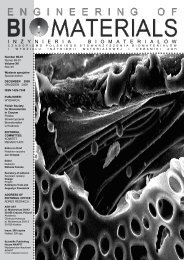69-72 - Polskie Stowarzyszenie BiomateriaÅów
69-72 - Polskie Stowarzyszenie BiomateriaÅów
69-72 - Polskie Stowarzyszenie BiomateriaÅów
Create successful ePaper yourself
Turn your PDF publications into a flip-book with our unique Google optimized e-Paper software.
56<br />
Screw designation L [mm] d s [mm] Screw type Material<br />
W1 40 6,6 cylindrical 316L<br />
W2 30 4,8 cylindrical 316L<br />
W3 20 4,8 cylindrical 316L<br />
W4 20 6,6 cylindrical 316L<br />
W5 40 6,6 cylindrical Ti6Al4V<br />
S1 40 7,6/4,5 conical Ti6Al4V<br />
S2 30 5,5/4,0 conical Ti6Al4V<br />
RYS.1. Przykład analizowanych śrub i parametry geometryczne.<br />
FIG.1. Picture of analysed transpedicular screws and analysed parameters.<br />
Dla wszystkich kręgów<br />
przeprowadzono<br />
analizę rentgenowską<br />
(zdjęcia Rtg) zarówno<br />
przed wprowadzeniem<br />
śrub transpedikularnych<br />
jak i po<br />
ich zamocowaniu. Na<br />
podstawie zdjęć Rtg<br />
wyznaczano również<br />
stosunek średnicy<br />
śruby do średnicy<br />
pedikulum (d s /d p )–<br />
rys.2b. Kręgi wraz<br />
z zaimplantowanymi<br />
śrubami transpedikularnymi<br />
mocowano<br />
w specjalnie do tego<br />
celu zaprojektowanym<br />
uchwycie. Konstrukcja<br />
uchwytu zaopatrzonego w przegub kulowy zapewniała<br />
zgodność kierunku zadanego obciążenia z kierunkiem osi<br />
śruby transpedikularnej. Badania prowadzono na maszynie<br />
wytrzymałościowej MTS MiniBionix 858. Test na wyrywanie<br />
polegał na obciążeniu zaimpantowanej śruby transpedikularnej<br />
siłą działającą w kierunku pokrywającym się z osią<br />
śruby. Prędkość obciążania wynosiła 50 N/s. We wszystkich<br />
przypadkach próba prowadzona była do momentu wyrwania<br />
śruby z kręgu.<br />
RYS.2. Zdjęcie kręgu z wprowadzonymi śrubami<br />
transpedikularnymi (a), schemat osadzenia śruby<br />
oraz analizowane parametry geometryczne (b),<br />
schemat układu mocującego do wyrywania śrub<br />
transpedikularnych z kręgu (c).<br />
FIG.2. Picture of vertebra with transpedicular<br />
screw (a), schema of inserting screw in vertebra<br />
and geometrical parameters (b), schema of set up<br />
extraction of transpedicular screw (c).<br />
thoracic part of the spine, and 9 vertebrae<br />
came from the lumbar part. Transpedicular<br />
screws were implanted in prepared vertebrae<br />
(rys.2a). The implantation was carried<br />
out by a physician – a specialist – in<br />
accordance with procedures binding for<br />
particular screw types.<br />
Roentgenographic analysis was conducted<br />
for all vertebrae (Rtg pictures) both<br />
before the insertion of transpedicular screws<br />
(to eliminate degeneration and pathological<br />
changes) and after the screws settlement<br />
(to determine implant insertion correctness).<br />
On the basis of Rtg pictures the screw<br />
diameter ratio to pediculum diameter was<br />
determined (d s /d p )–FIG.2b.<br />
Vertebrae with implanted transpedicular<br />
screws were settled in a set up specially<br />
designed for this purpose. The set up construction,<br />
with cup-and-ball joint, assured<br />
the consistency of the direction of the<br />
determined load with the direction of tarnspedicular screw<br />
axis. The research was performed using testing machine<br />
(MTS MiniBionix 858). Pull-out test consisted in loading<br />
the implanted transpedicular screw with force acting in the<br />
direction consistent with the screw axis. Load velocity made<br />
50N/s. In all cases the test was continued until the screw<br />
was pulled out of the vertebra.<br />
Results and discussion<br />
Wyniki i dyskusja<br />
Na podstawie przeprowadzonych testów dla każdej z<br />
badanych śrub otrzymano przebieg zmiany siły działającej<br />
na śrubę w funkcji jej przemieszczenia. Siłę wyrywającą P W<br />
On the basis of the conducted tests, force change<br />
course of the force acting on a screw in the function of its<br />
displacement was obtained for each of the tested screws.<br />
The pulling out force P W was defined as maximum force<br />
value registered during the test. FIG.3 presents average<br />
Screw designation n P W [N] (SD [N]) d S /d P (SD)<br />
W1 6 1218 (192,3) 0,78 (0,11)<br />
W2 6 944 (228,8) 0,71 (0,15)<br />
W3 6 619 (146,8) 0,<strong>69</strong> (0,04)<br />
W4 5 762 (233,6) 0,76 (0,08)<br />
W5 6 1487 (128,9) 0,80 (0,03<br />
S1 5 1565 (181,3) 0,79 (0,06)<br />
S2 6 1365 (230,4) 0,76 (0,09)<br />
RYS.3. Zestawienie średnich wartości siły wyrywającej P W dla badanych śrub transpedikularnych.<br />
FIG.3. Average value of pull-out force for investigated screws.













